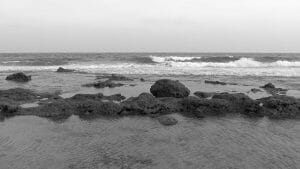Intertidal zones are marine biomes that are underwater during high tide and exposed during low tide. The receding water at low tide reveals a variety of habitats and sea creatures that are normally hidden. The intertidal zone is also known as the seashore, foreshore, and the littoral zone.
Fact #1 – Intertidal Zones are Harsh Habitats
Creatures that live or spend part of their day in intertidal zones must be well adapted to the extremes. For example, organisms that wash up on the shore as the tide recedes are transported from a watery world into a world with a gaseous atmosphere that can cause them to dry out. On hot sunny days, they must be adapted to high temperatures. Also, creatures must be able to withstand the pounding action of the waves as the tides go out and come in.
Fact #2 – The Neritic Zone Has the Greatest Biodiversity and Productivity in the Ocean
The neritic zone extends from the margin of the intertidal zone to ocean depths of about 650 feet (200 meters). Due to the stable temperatures, oxygenation of the water, low pressure, and silt content, this zone is home to a vast array of life and large populations of organisms. These include phytoplankton, zooplankton, protists, small fish, and shrimp.
Fact #3 – The Intertidal Zone Has Three Regions
The three areas that makeup the intertidal zone are the low, middle, and high zones. They are divided up based on overall average exposure of the area. The low zone is the area exposed to the atmosphere when the tide is at its lowest point. The middle zone experiences regular exposure and submersion during the tidal cycles. The high zone is covered by water when the tide is at its highest.
Fact #4 – The World’s Highest Tides are in Canada
The Bay of Fundy in southeastern Canada has a 65-foot (20 meter) difference between high and low tides, the highest tidal difference in the world. The bay has distinct features that make these high tides possible. The Bay of Fundy is very deep and consequently contains an enormous amount of water, and the unique shape of the bay causes the water to oscillate (swing back and forth) over a time period of 12 to 13 hours. The oscillation period coincides with high tide on the Atlantic Ocean every 12 hours and 26 minutes which causes the water in the bay to resonate (be prolonged).
Fact #5 – The Intertidal Zone Provides Food for a Variety of Organisms
The organisms revealed on the shore at low tide provide food for dozens of species of birds like herons, eagles, gulls, and other shorebirds. Even larger mammals like bears, raccoons, wolves, deer, and otter supplement their diets with marine creatures exposed at low tide. Also, for thousands of years, humans have migrated to the shores of the oceans to live and forage for food at low tide.

The image above shows the intertidal zone in Lakshadweep off the coast of Kerala, India.
References
- Bay of Fundy Tides: The Highest in the World! (n.d.). Retrieved from https://www.bayoffundy.com/about/highest-tides/
- Intertidal Zone. (n.d.). In Wikipedia. Retrieved April 25, 2018 from https://en.wikipedia.org/wiki/Intertidal_zone
- OpenStax College. (2018). Concepts of Biology. Houston, TX. OpenStax CNX. Retrieved from http://cnx.org/contents/b3c1e1d2-839c-42b0-a314-e119a8aafbdd@9.39
